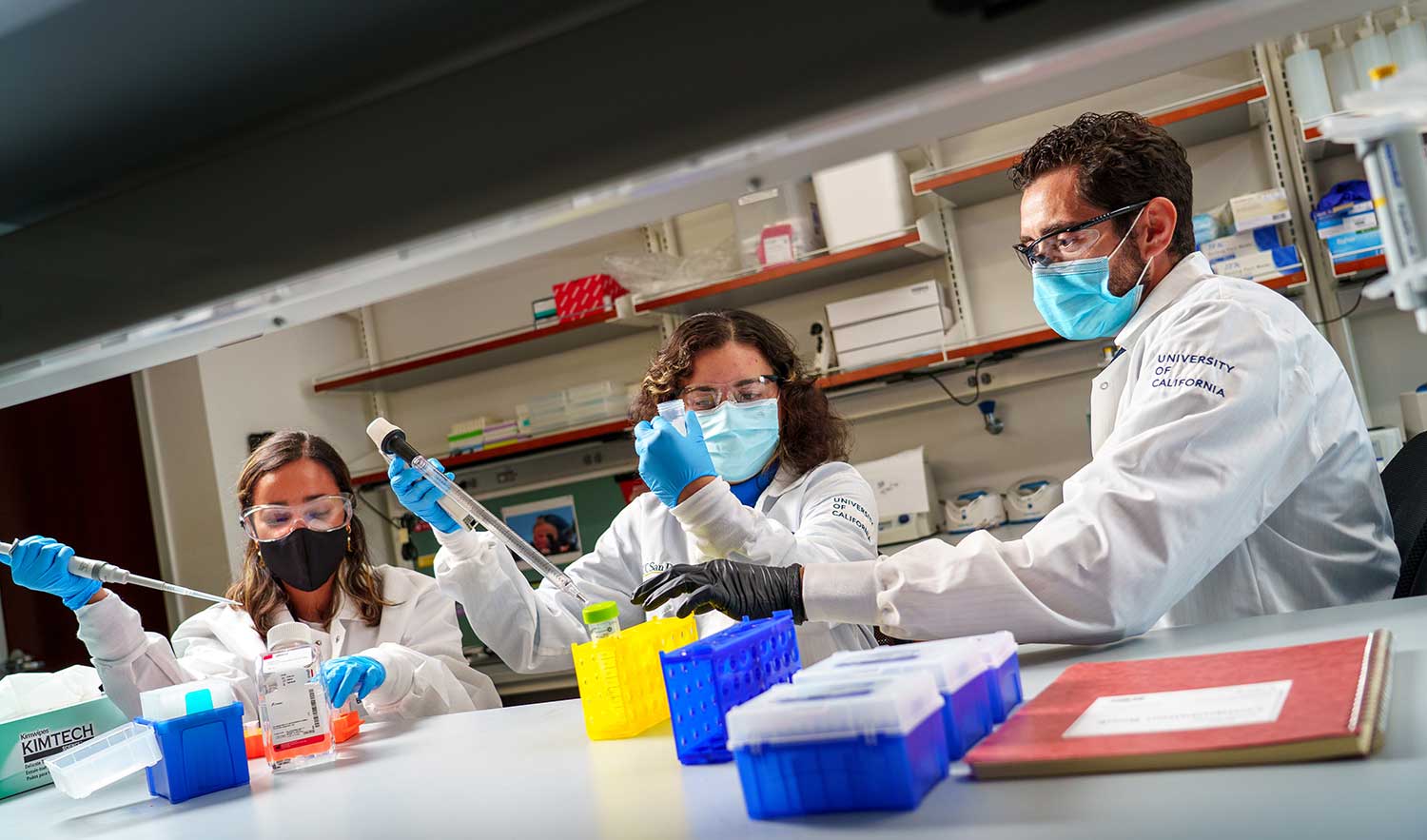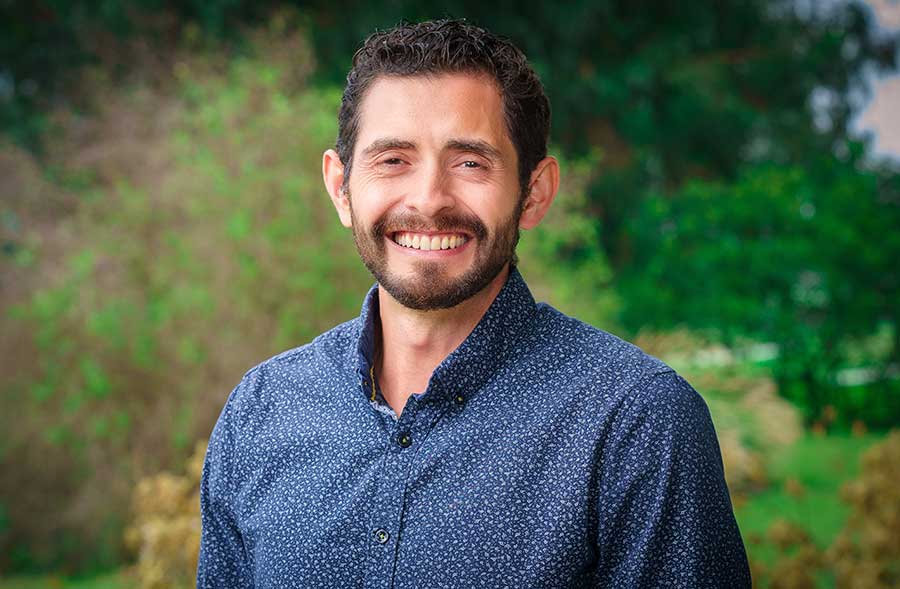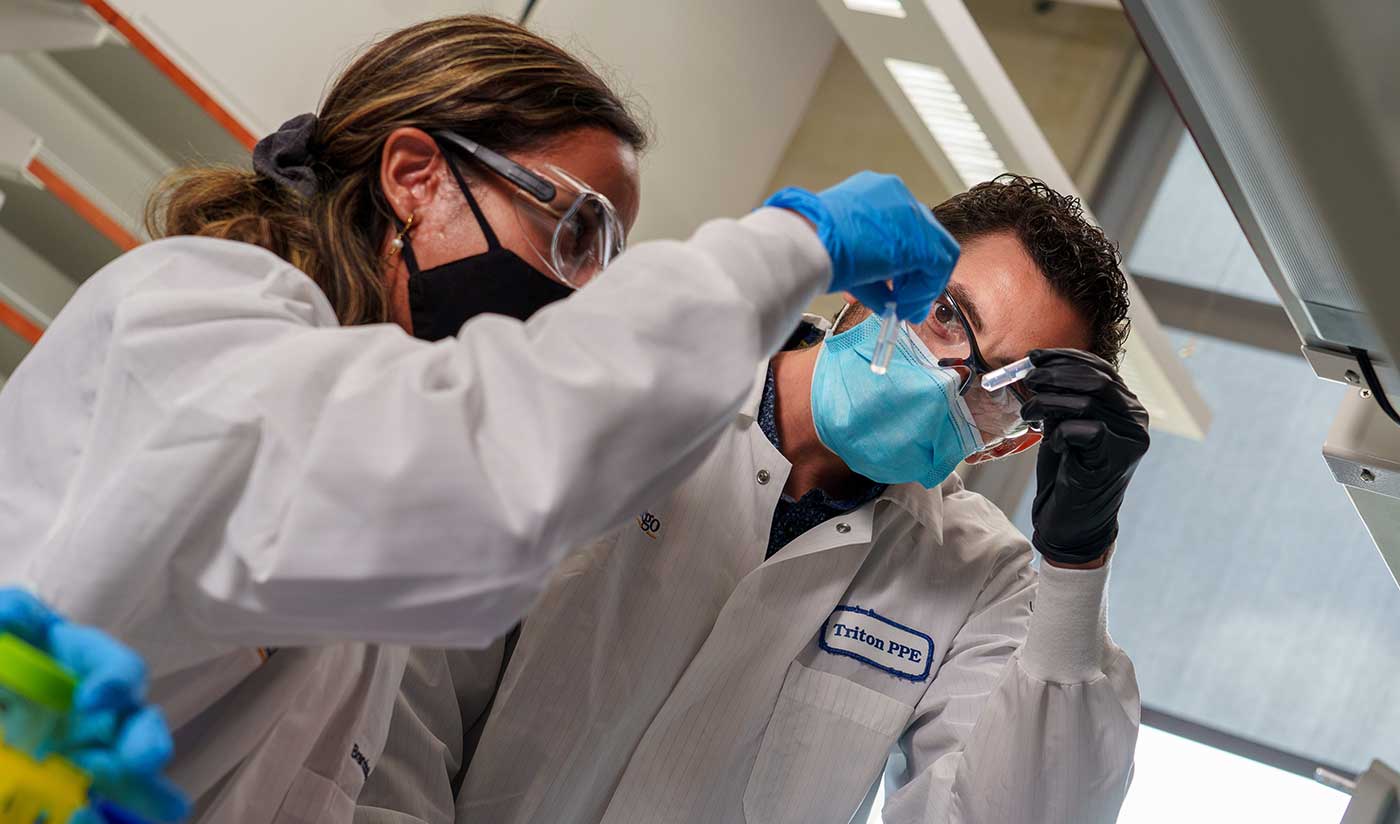By:
- Katherine Connor
Published Date
By:
- Katherine Connor
Share This:

Bioengineering graduate students Nicole Felix-Velez and Talia Baddour work with Professor Brian Aguado to understand sex-based differences in cardiovascular diseases. Photos by David Baillot/UC San Diego Jacobs School of Engineering
.Developing Sex-specific Treatments for Heart Disease
UC San Diego bioengineer advances equity in science, and among scientists
As a heart fails, a woman's ventricular wall increases in thickness relative to a man's. And in heart valve disease, men show more calcified tissue growth, while women develop more fibrotic, scar-like tissue. Yet, treatments for both diseases remain strikingly similar for both men and women, despite the differences in disease progression.
Brian Aguado, a professor of bioengineering at the University of California San Diego, aims to change that. He is studying sex-specific differences in disease—starting with cardiovascular disease—from the molecular scale all the way up to the organism level. He uses bioengineering tools to develop more relevant, sex-specific models and treatments for cardiovascular disease, enabling better clinical outcomes for patients who have long been ignored.
“Cardiovascular disease is the leading cause of death in men and women, but we still don’t fully understand the mechanisms that cause it—especially in women—simply because our models for understanding disease are largely male biased,” said Aguado, one of the 27 new faculty who joined the Jacobs School of Engineering in the last two years. “This has created a gap in understanding as far as what makes men and women go through cardiovascular disease differently and how we can address that head on.”
And Aguado doesn’t just focus on equity in his research. He’s also a strong advocate of equity and diversity among the researchers doing this work, and co-founded the LatinX in Biomedical Engineering (LatinXinBME) community to support diversity within the scientific community.
“In academic spaces, I feel like a lot of folks are encouraged to assimilate—to adopt the current average,” said Aguado. “I think it's super important to bring your whole self to the workplace, and hope that my lab can inspire populations historically excluded from the sciences to do work that supports their respective communities.”
Diversifying the biomedical field and workforce
Aguado co-founded the LatinxinBME community with friend and fellow scientist of Colombian descent Ana Maria Porras, now a professor at the University of Florida, after a conference in 2018 helped them realize the value of community in fighting feelings of isolation. What started as a small Slack group to help these LatinX researchers keep in touch has now grown to a community of more than 300 members from around the country, seeking mentorship, advice, and a sense of inclusion.
“We try to help each other through key transition points in our careers: from undergraduate to grad school; grad school to postdocs; postdocs to faculty; we share with each other what life is like, and any advice we can give. It’s been a beautiful tool and community for mentorship and helping each other through academic and industry careers,” said Aguado.

Aguado, a first-generation Colombian American, co-founded the LatinX in Biomedical Engineering group to support diversity within the scientific community.
The group has now established an executive board, and holds regular research symposia along with social and mentorship events. The sense of inclusion he found through LatinXinBME was also one reason Aguado felt UC San Diego was the best place for his research, and himself, to thrive.
“I’m first-generation Colombian American, so I've just always been immersed in Colombian culture at home, but at the same time have come to realize that it’s a rarity in academic spaces,” he said. “The fact that I have colleagues here at UC San Diego that speak Spanish, it means a lot. That feeling of inclusion just has helped me in so many ways that it feels like LatinXinBME is a way I can create space to welcome people to academic spaces and help them feel like they are not alone.”
Aguado said it’s no accident that he’s working toward equity through his scientific and outreach efforts.
“I see this marriage between the diversity work I do with LatinXinBME and increasing equity in science through social means, but then also increasing it in science through my lab. That’s another reason UC San Diego is such a good fit for me, because I feel that both of these aspects are valued in this academic community.”
One-size-fits-all vs. precision medicine
Aguado’s scientific goal sits in between two healthcare paradigms: one-size-fits-all treatments that ignore differences based on sex, race, and age; and precision medicine, with treatments tailored down to the individual level. While the goals of precision medicine are worth exploring, Aguado said he has concerns about how accessible this level of care will be to the general population, and in particular, to underserved communities.
He envisions a more effective middle ground.
“My long-term vision is to not just focus on sex as a variable; I think we can also incorporate age and ancestry into our models, really embracing the whole idea of precision medicine but not making it so specific to individual patients. Instead, we could think of how we can stratify patients into groups and take into account what makes us unique biologically, so that we can better cater treatments to certain populations.”
Gender is another variable that Aguado considers, particularly as it relates to transgender people’s health outcomes with everything from hormone therapy treatments, to molecular differences impacting cardiovascular disease outcomes.
His current work on sex-specific differences in cardiovascular disease is a first step toward this larger goal. To understand how and why heart diseases affect men and women differently, and how we can develop more tailored treatments for them, Aguado and his team of student researchers study sex-based differences at a variety of scales, from within single cells, to the extracellular matrix, and to the immune system, tissue and organism level.
Studying sex-based differences

The Aguado lab studies sex-specific differences in disease from the molecular scale all the way up to the organism level.
At the smallest scale, Aguado and his team recently found that cells taken from the heart valve tissues of men and women with aortic valve disease respond very differently to the same drug. Using hydrogel biomaterials developed in his lab, they were able to tie some of these differences in response to genes on the cell’s X chromosome, explaining why female cells—which have two X chromosomes—express increased activity. They’re now working to understand how genetic and epigenetic changes caused by these sex chromosomes can lead to changes in cell behavior, and ultimately study how these changes could be harnessed to impact healing after a cardiac event.
Moving up from understanding the cellular to the extracellular level—the complex cocktail of proteins, hormones and biochemicals that surround cells—Aguado collaborates with cardiologists to collect serum samples from patients with aortic valve disease. He found that using this extracellular serum to culture cells resulted in cells with different behaviors based on the sex of the patient.
“We have provided this really nice bridge between in vitro disease modeling and in vivo patient outcomes, simply by taking into account these sex-specific extracellular components,” he said.
While understanding what underpins these differences is a scientific challenge, the biggest hurdle is simply making it a priority to incorporate both male and female models into research.
“It’s not hard, you just need to think about it,” said Aguado. “For example, in my previous lab work, we would isolate cells from pig hearts, but we did not know the biological sex of the hearts. After consulting the literature and recognizing sex differences in the heart, I called up the meat company that sent the hearts, and asked if they could ship separate boxes of male and female hearts. To my surprise, they said, “no problem.” It just takes initiative to acknowledge that there are these clinical differences between the sexes, and incorporate that into your studies.”
Developing new treatments
All this information that Aguado and other researchers are learning about sex-specific differences at the cellular, extracellular, immune system and organ levels, is setting the stage to not only prescribe existing treatments more effectively based on sex, but to also develop new ones.
For example, one project that Aguado plans to tackle is developing polymer scaffolds—sponge-like biomaterials—that have been engineered to recruit certain populations of immune cells as a strategy to control the male or female immune response after cardiac injury, and improve tissue regeneration after a heart attack.
Modulating the immune system in this way to encourage optimum healing based on what we know about how sex impacts cardiovascular disease and healing would be a crowning achievement.
“I believe we can find a middle ground between something that might work for large groups of people but is missing certain populations—like cardiovascular disease which has been largely based on male animal models—versus a completely customized approach that might not be accessible for every patient. If my work can show that there are more effective ways to treat certain groups of patients, then I’ll feel like I made an impact. Because at the very least we’re not ignoring 50 percent of the population with our research.”
Share This:
You May Also Like
Stay in the Know
Keep up with all the latest from UC San Diego. Subscribe to the newsletter today.



